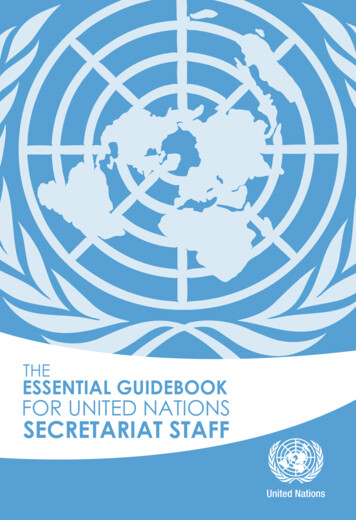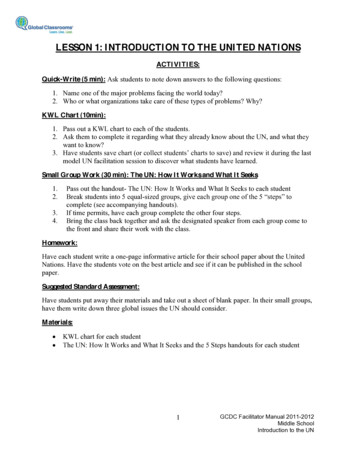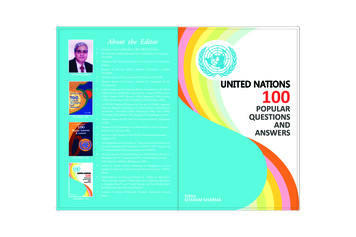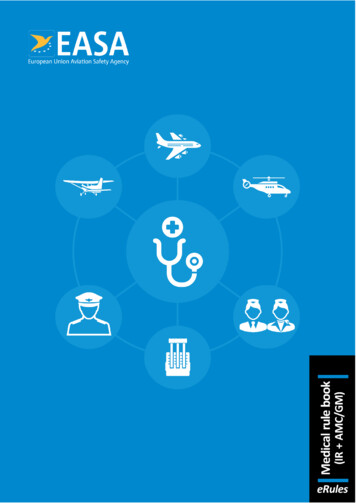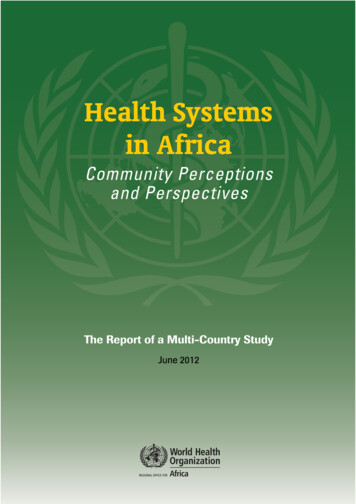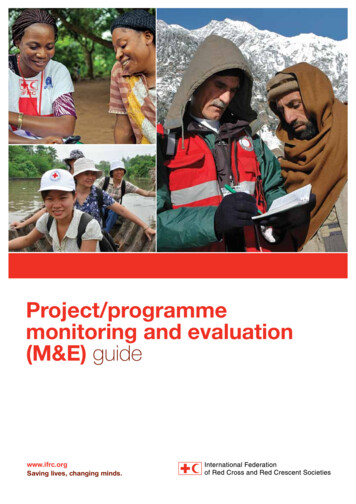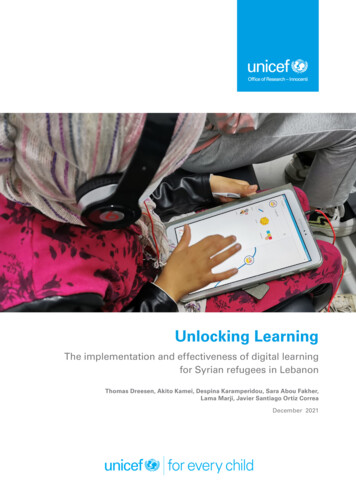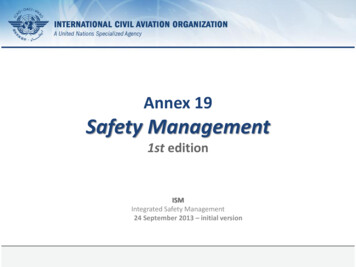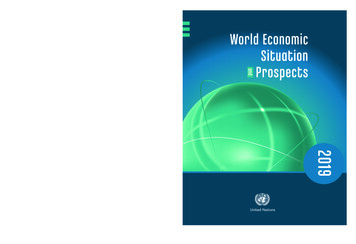
Transcription
Statistical annex
Country classificationsData sources, country classificationsand aggregation methodologyThe statistical annex contains a set of data that the World Economic Situation andProspects (WESP) employs to delineate trends in various dimensions of the world economy.Data sourcesThe annex was prepared by the Economic Analysis and Policy Division (EAPD) of the Department of Economic and Social Affairs of the United Nations Secretariat (UN/DESA). Itis based on information obtained from the Statistics Division and the Population Divisionof UN/DESA, as well as from the five United Nations regional commissions, the UnitedNations Conference on Trade and Development (UNCTAD), the United Nations WorldTourism Organization (UNWTO), the International Monetary Fund (IMF), the WorldBank, the Organization for Economic Cooperation and Development (OECD), and national and private sources. Estimates for the most recent years were made by EAPD inconsultation with the regional commissions, UNCTAD, UNWTO and participants inProject LINK, an international collaborative research group for econometric modellingcoordinated jointly by EAPD and the University of Toronto. Forecasts for 2019 and 2020are primarily based on the World Economic Forecasting Model of EAPD, with supportfrom Project LINK.Data presented in WESP may differ from those published by other organizations fora series of reasons, including differences in timing, sample composition and aggregationmethods. Historical data may differ from those in previous editions of WESP because ofupdating and changes in the availability of data for individual countries.Country classificationsFor analytical purposes, WESP classifies all countries of the world into one of three broadcategories: developed economies, economies in transition and developing economies. Thecomposition of these groupings, specified in tables A, B and C, is intended to reflect basiceconomic country conditions. Several countries (in particular the economies in transition)have characteristics that could place them in more than one category; however, for purposesof analysis, the groupings have been made mutually exclusive. Within each broad category,some subgroups are defined based either on geographical location or on ad hoc criteria, suchas the subgroup of “major developed economies”, which is based on the membership of theGroup of Seven. Geographical regions for developing economies are as follows: Africa, EastAsia, South Asia, Western Asia, and Latin America and the Caribbean.11Names and composition of geographical areas follow those specified in the statistical paper entitled“Standard country or area codes for statistical use” (ST/ESA/STAT/SER.M/49/Rev). Available M/Series M49 Rev4(1999) en.pdf.
168World Economic Situation and Prospects 2019In parts of the analysis, a distinction is made between fuel exporters and fuel importers from among the economies in transition and the developing countries. An economy isclassified as a fuel exporter if the share of fuel exports in its total merchandise exports isgreater than 20 per cent and the level of fuel exports is at least 20 per cent higher than thatof the country’s fuel imports (table D). This criterion is drawn from the share of fuel exportsin the total value of world merchandise trade. Fuels include coal, oil and natural gas.For other parts of the analysis, countries have been classified by their level of development as measured by per capita gross national income (GNI). Accordingly, countries havebeen grouped as high-income, upper-middle-income, lower-middle-income and low-income(table E). To maintain compatibility with similar classifications used elsewhere, the threshold levels of GNI per capita are those established by the World Bank. Countries with lessthan 995 GNI per capita are classified as low-income countries, those with between 996and 3,895 as lower-middle-income countries, those with between 3,896 and 12,055 asupper-middle-income countries, and those with incomes of more than 12, 056 as high-income countries. GNI per capita in dollar terms is estimated using the World Bank Atlasmethod,2 and the classification in table E is based on data for 2017.The list of the least developed countries (LDCs) is decided upon by the UnitedNations Economic and Social Council and, ultimately, by the General Assembly, on thebasis of recommendations made by the Committee for Development Policy. The basic criteria for inclusion require that certain thresholds be met with regard to per capita GNI, ahuman assets index and an economic vulnerability index.3 As of March 2018, there were47 LDCs (table F).WESP also makes reference to the group of heavily indebted poor countries (HIPCs),which are considered by the World Bank and IMF as part of their debt-relief initiative (theEnhanced HIPC Initiative).4 In October 2017, there were 39 HIPCs (see table G).Aggregation methodologyAggregate data are either sums or weighted averages of individual country data. Unlessotherwise indicated, multi-year averages of growth rates are expressed as compound annualpercentage rates of change. The convention followed is to omit the base year in a multi-yeargrowth rate. For example, the 10-year average growth rate for the decade of the 2000swould be identified as the average annual growth rate for the period from 2001 to 2010.WESP utilizes exchange-rate conversions of national data in order to aggregate outputof individual countries into regional and global totals. The growth of output in each groupof countries is calculated from the sum of gross domestic product (GDP) of individualcountries measured at 2012 prices and exchange rates. Data for GDP in 2012 in nationalcurrencies were converted into dollars (with selected adjustments) and extended forwardsand backwards in time using changes in real GDP for each country. This method suppliesa reasonable set of aggregate growth rates for a period of about 15 years, centred on 2012.2See tions.3Handbook on the Least Developed Country Category: Inclusion, Graduation and Special Support Measures(United Nations publication, Sales No. E.07.II.A.9). Available from dp publications/2008cdphandbook.pdf.4International Monetary Fund, Debt Relief Under the Heavily Indebted Poor Countries (HIPC) Initiative.Available from 6/08/01/16/11/Debt- itiative.
169Country classificationThe exchange-rate-based method differs from the one mainly applied by the IMFfor their estimates of world and regional economic growth, which is based on purchasingpower parity (PPP) weights. Over the past two decades, the growth of world gross product(WGP) on the basis of the exchange-rate-based approach has been below that based onPPP weights. This is because developing countries, in the aggregate, have seen significantlyhigher economic growth than the rest of the world in the 1990s and 2000s and the sharein WGP of these countries is larger under PPP measurements than under market exchangerates. Table I.1 in chapter I reports world output growth with PPP weights as a comparator.Table ADeveloped economiesa Member of Euro area.EuropeNorth AmericaCanadaUnited StatesDeveloped Asiaand PacificAustraliaJapanNew ZealandEuropean PortugalaSpainaSwedenUnited KingdombOther EuropeIcelandNorwaySwitzerlandMajor developedeconomies (G7)CanadaJapanFranceGermanyItalyUnited KingdomUnited Statesb At the time of publishing, theUnited Kingdom was a memberof the EU and is therefore isincluded in all EU aggregations.The country is scheduled towithdraw from the EU at the endof March 2019.c Used in reference to the 13countries that joined the EUsince 2004.EU-13cBulgariaCroatiaCyprusaCzech ndRomaniaSlovakiaaSloveniaaTable BEconomies in transitionSouth-Eastern EuropeAlbaniaBosnia and HerzegovinaMontenegroSerbiaThe former Yugoslav Republicof MacedoniaCommonwealth of Independent States and KyrgyzstanRepublic of MoldovaRussian a Georgia officially left theCommonwealth of IndependentStates on 18 August 2009.However, its performance isdiscussed in the context of thisgroup of countries for reasonsof geographic proximityand similarities in economicstructure.b Starting in 2010, data forthe Ukraine excludes thetemporarily occupied territoryof the Autonomous Republic ofCrimea and Sevastopol.
170World Economic Situation and Prospects 2019Table CaDeveloping economies by regionAfricaSouthern AfricaEast tiusMozambiqueNamibiaSouth AfricaZambiaZimbabweBrunei DarussalamCambodiaChinaDemocratic People’sRepublic of KoreacFijiHong Kong SARdIndonesiaKiribatiLao People’s DemocraticRepublicMalaysiaMongoliaMyanmarPapua New GuineaPhilippinesRepublic of KoreaSamoaSingaporeSolomon IslandsTaiwan Province of ChinaThailandTimor-LesteVanuatuViet dad and TobagoCameroonCentral AfricanRepublicChadCongoEquatorial GuineaGabonSao Tome andPrinicipeWest AfricaBeninBurkina FasoCabo VerdeCôte d’IvoireGambia (IslamicEast AfricaRepublic of ic RepublicLiberiaof the lKenyaSierra LeoneMadagascarTogoRwandaSomaliaSouth SudancUgandaUnited Republicof Tanzaniamonitored by the GlobalEconomic MonitoringBranch of EAPD.b Throughout the reportthe term ‘East Asia’ is usedin reference to this set ofdeveloping countries, andexcludes Japan.c The country coverage in WESP2019 was expanded to includeSouth Sudan, State of Palestineand Democratic People’sRepublic of Korea.d Special AdministrativeRegion of China.Latin Americaand the CaribbeanNorth AfricaCentral Africaa Economies systematicallyAsiaSouth AsiaAfghanistanBangladeshBhutanIndiaIran (Islamic Republic of)MaldivesNepalPakistanSri LankaWestern audi ArabiaState of PalestinecSyrian Arab RepublicTurkeyUnited Arab EmiratesYemenMexico and Central AmericaCosta RicaCubaDominican RepublicEl aSouth AmericaArgentinaBolivia (PlurinationalState nezuela (BolivarianRepublic of)
Country classificationTable DFuel-exporting countriesDeveloping countriesDevelopedcountriesEconomiesin anFederationTurkmenistanLatin Americaand theCaribbeanAfricaBoliviaAlgeria(Plurinational AngolaState of)CameroonColombiaChadEcuadorCongoTrinidadand Tobago EquatorialGuineaVenezuelaGabon(BolivarianRepublic of) LibyaNigeriaSudanEast AsiaSouth AsiaBruneiDarussalamIran (IslamicRepublic of)DemocraticPeople’sRepublic ofKoreaWestern apua NewGuineaQatarSaudi ArabiaUnited ArabEmirates171
172World Economic Situation and Prospects 2019Table EaEconomies by per capita GNI in June atiacCyprusCzech ng Kong viaLithuaniaLuxembourgMaltaNetherlandsNew c of KoreaSaudi ArabiaSingaporeSlovak RepublicSloveniaSpainSwedenSwitzerlandTaiwan Province ofChinaTrinidad and TobagoUnited Arab EmiratesUnited KingdomUnited niacAzerbaijanBelarusBelizeBosnia osta RicaCubaDominican RepublicEcuadorEquatorial GuineaFijiGabonGuatemalacGuyanaIran (IslamicRepublic groNamibiaParaguayPeruRomaniaRussian FederationSamoaSerbiaSouth AfricaSurinameThailandThe former YugoslavRepublic ofMacedoniaTurkeyTurkmenistanVenezuela (BolivarianRepublic of)AngolaBangladeshBhutanBolivia (PlurinationalState of)Cabo VerdeCambodiaCameroonCongoCôte d’IvoireDjiboutiEgyptEl KenyaKiribatiKyrgyzstanLao liaMoroccoMyanmarNicaraguaNigeriaPakistanPapua New GuineaPhilippinesRepublic of MoldovaSão Tomé andPrincipeSolomon IslandsSri LankaState of anuatuViet NamZambiaLow-incomeAfghanistanBeninBurkina FasoBurundiCentral AfricanRepublicChadComorosDemocratic People’sRepublic of KoreaDemocratic Republicof the ndaSenegalSierra LeoneSomaliaSouth SudanSyrian ArabRepublicbTajikistanbTogoUgandaUnited Republic ofTanzaniaYemenbZimbabwea Economies systematically monitored for the World Economic Situation and Prospects report and included in the United Nations’ global economic forecast.b Indicates the country has been shifted downward by one category from previous year’s classification.c Indicates the country has been shifted upward by one category from previous year’s classification.d Special Administrative Region of China.
173Country classificationTable FLeast developed countries (as of March 2018)AfricaAngolaBeninBurkina FasoBurundiCentral African RepublicChadComorosDemocratic Republic ofthe sauLesothoLiberiaMadagascarEast AsiaMalawiMaliMauritaniaMozambiqueNigerRwandaSao Tome and PrincipeSenegalSierra LeoneSomaliaSouth SudanSudanTogoUgandaUnited Republicof TanzaniaZambiaCambodiaKiribatiLao imor LesteTuvaluaVanuatuSouth AsiaAfghanistanBangladeshBhutanNepalWestern AsiaLatin Americaand the CaribbeanYemenHaitia Not included in the WESP discussion because of insufficient data.Table GHeavily indebted poor countries (as of October 2017)Post-completion point HIPCsaAfghanistanBeninBoliviaBurkina FasoBurundiCameroonCentral African RepublicChadComorosCongoCôte D’IvoireDemocratic Republic of the ozambiqueNicaraguaNigerRwandaSao Tomé and PrincipeSenegalSierra LeoneTogoUgandaUnited Republic of TanzaniaZambiaPre-decision point HIPCsbEritreaSomaliaSudana Countries that have qualified for irrevocable debt relief under the HIPC Initiative.b Countries that are potentially eligible and may wish to avail themselves of the HIPC Initiative or the Multilateral Debt Relief Initiative (MDRI).
174World Economic Situation and Prospects 2019Table HSmall island developing StatesUnited Nations membersNon-UN members/Associate membersof the Regional CommissionsAntigua and BarbudaMarshall IslandsAmerican adosPalauBermudaBelizePapua New GuineaBritish Virgin IslandsCabo VerdeSaint Kitts and NevisCayman IslandsComorosSaint LuciaCubaSaint Vincent andthe GrenadinesCommonwealth ofNorthern MarianasDominicaCook IslandsDominican RepublicSamoaCuraçaoFederated Statesof MicronesiaSão Tomé and PríncipeFrench adaSolomon yanaTimor-LesteNew CaledoniaHaitiTongaNiueJamaicaTrinidad and TobagoPuerto RicoKiribatiTuvaluSint MaartenMaldivesVanuatuTurks and Caicos IslandsU.S. Virgin IslandsTable ILandlocked developing countriesLandlocked developing countriesAfghanistanKazakhstanRepublic of MoldovaArmeniaKyrgystanRwandaAzerbaijanLao People’s DemocraticRepublicSouth SudanBhutanBolivia (Plurinational State of)LesothoBotswanaMalawiThe former Yugoslav Republicof MacedoniaBurkina FasoMaliTurkmenistanBurundiMongoliaUgandaCentral African guayZimbabweEthiopiaTajikistan
175Country classificationTable JInternational Organization for Standardization of Country ted Arab EmiratesArgentinaArmeniaAntigua and inBurkina FasoBangladeshBulgariaBahrainBahamasBosnia andHerzegovinaBelarusBelizeBolivia (PlurinationalState of)BrazilBarbadosBrunei DarussalamBhutanBotswanaCentral AfricanRepublicCanadaSwitzerlandChileChinaCôte D’IvoireCameroonDemocratic Republicof the CongoCongoColombiaComorosCabo VerdeCosta RicaCubaCyprusCzech RepublicGermanyDjiboutiDominicaDenmarkDominican aEthiopiaFinlandFijiFranceMicronesia (FederatedStates of)GabonUnited Kingdom ofGreat Britain andNorthern IrelandGeorgiaGhanaGuineaGambiaGuinea BissauEquatorial aitiHungaryIndonesiaIndiaIrelandIran (IslamicRepublic tanKenyaKyrgyzstanCambodiaKiribatiSaint Kitts and NevisRepublic of KoreaKuwaitLao iberiaLibyaSaint LuciaLiechtensteinSri Republic of MoldovaMadagascarMaldivesMexicoMarshall IslandsThe former YugoslavRepublic NigeriaNicaraguaNetherlandsNorwayNepalNauruNew ZealandOmanPakistanPanamaPeruPhilippinesPalauPapua New GuineaPolandDemocratic People’sRepublic of KoreaPortugalParaguayState of WSMYEMZAFZMBZWECountryRomaniaRussian FederationRwandaSaudi ArabiaSudanSenegalSingaporeSolomon IslandsSierra LeoneEl SalvadorSan MarinoSomaliaSerbiaSouth SudanSao Tome eychellesSyrian Arab r-LesteTongaTrinidad and TobagoTunisiaTurkeyTuvaluUnited Republic ofTanzaniaUgandaUkraineUruguayUnited States ofAmericaUzbekistanSaint Vincent and theGrenadinesVenezuela (BolivarianRepublic of)Viet NamVanuatuSamoaYemenSouth AfricaZambiaZimbabwe
Annex tables
179Annex tablesTable A.1Developed economies: rates of growth of real GDP, 2010–2020Annual percentage change2010-2017aDeveloped economiesUnited StatesCanadaJapanAustraliaNew ZealandEuropean ainSwedenUnited KingdomEU-13BulgariaCroatiaCyprusCzech maniaSlovakiaSloveniaOther EuropeIcelandNorwaySwitzerlandMemorandum itemsNorth AmericaDeveloped Asia and PacificEuropeMajor developed economiesEuro area2017 2018b 2019c 12.02.41.72.02.01.92.01.52.01.81.9Source: UN/DESA, based on data of the United Nations Statistics Division and individual national sources.Note: Regional aggregates calculated at 2012 prices and exchange rates.a Average percentage change.b Partly estimated.c Baseline scenario forecasts, based in part on Project LINK and UN/DESA World Economic Forecasting Model.
180World Economic Situation and Prospects 2019Table A.2Economies in transition: rates of growth of real GDP, 2010–2020Annual percentage change2010–2017aEconomies in transitionSouth-Eastern EuropeAlbaniaBosnia and HerzegovinaMontenegroSerbiaThe former Yugoslav Republicof MacedoniaCommonwealth of IndependentStates and GeorgiadCommonwealth of IndependentStates and Georgia net fuel exportersAzerbaijanKazakhstanRussian FederationTurkmenistanCommonwealth of IndependentStates and Georgia net fuel importersArmeniaBelarusGeorgiadKyrgyzstanRepublic of MoldovaTajikistanUkraineeUzbekistanf2017 2018b 2019c 5.8Source: UN/DESA, based on data of the United Nations Statistics Division and individual national sources.Note: Regional aggregates calculated at 2012 prices and exchange rates.a Average percentage change.b Partly estimated.c Baseline scenario forecasts, based in part on Project LINK and the UN/DESA World Economic Forecasting Model.d Georgia officially left the Commonwealth of Independent States on 18 August 2009. However, its performance is discussed in the context of this group ofcountries for reasons of geographic proximity and similarities in economic structure.e Starting in 2010, data for the Ukraine excludes the temporarily occupied territory of the Autonomous Republic of Crimea and Sevastopol.f Based on 2019 criteria, Uzbekistan is now considered a net fuel importer.
181Annex tablesTable A.3Developing economies: rates of growth of real GDP, 2010–2020Annual percentage change2010–2017a 2010Developing countriesdAfricaNorth isiaEast AfricaBurundiComorosDemocratic Republic of the omaliaSouth SudanUgandaUnited Republic of TanzaniaCentral AfricaCameroonCentral African RepublicChadCongoEquatorial GuineaGabonSao Tome and PrincipeWest AfricaBeninBurkina FasoCabo VerdeCôte D’IvoireGambia (Islamic Republic of the)GhanaGuineaGuinea 11201220132014201520162017 2018b 2019c .06.11.89.9-4.13.42.82.22.2124.7 18.54.85.07.04.69.6 10.44.65.92.51.48.84.72.62.6-51.5 30.23.24.75.17.37.3-0.54.55.42.9 4.16.55.84.94.85.65.2
182World Economic Situation and Prospects 2019Table A.3Developing economies: rates of growth of real GDP, 2010–2020 (continued)Annual percentage change2010–2017a 2010NigeriaSenegalSierra LeoneTogoSouthern MozambiqueNamibiaSouth AfricaZambiaZimbabweAfrica - net fuel exportersAfrica - net fuel importersEast and South AsiaEast AsiaBrunei DarussalamCambodiaChinaDemocratic People’s Republic ofKoreaFijiHong Kong SARfIndonesiaKiribatiLao People's Democratic RepublicMalaysiaMongoliaMyanmarePapua New GuineaPhilippinesRepublic of KoreaSamoaSingaporeSolomon IslandsTaiwan Province of ChinaThailandTimor-LesteVanuatuViet Nam201120122013201420152016 2017b 2018c 2019c 6.5
183Annex tablesTable A.3Developing economies: rates of growth of real GDP, 2010–2020 (continued)Annual percentage change2010–2017a 2010South AsiaAfghanistaneBangladesheBhutanIndiaeIran (Islamic Republic of)eMaldivesNepalePakistaneSri LankaEast and South Asia net fuel exportersEast and South Asia net fuel importersWestern AsiaWestern Asia - net fuel exportersBahrainIraqKuwaitOmanQatarSaudi ArabiaUnited Arab EmiratesWestern Asia - net fuel exportersIsraelJordanLebanonState of PalestineSyrian Arab RepublicTurkeyYemenLatin America and the CaribbeanSouth AmericaArgentinaBolivia (Plurinational State nezuela (Bolivarian Republic of)201120122013201420152016 2017b 2018c 2019c 20.5
Country classifications Data sources, country classifications and aggregation methodology The statistical annex contains a set of data that the World Economic Situation and Prospects (WESP .
